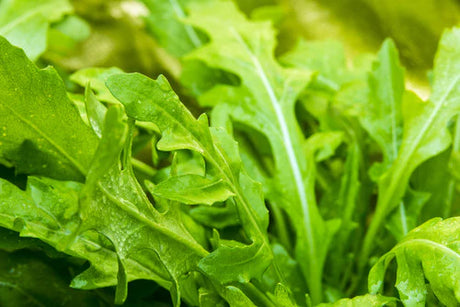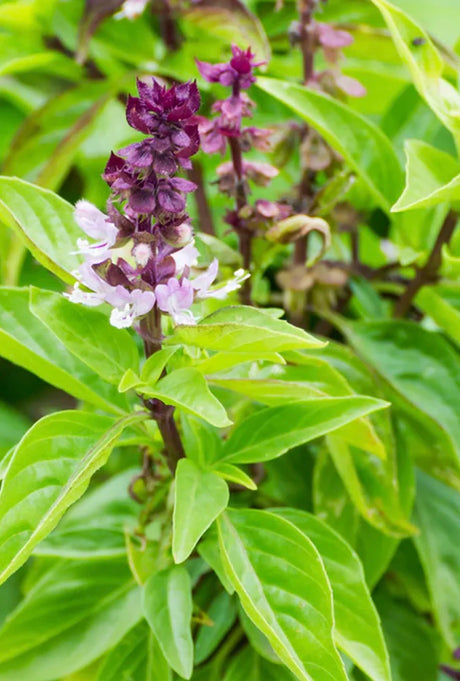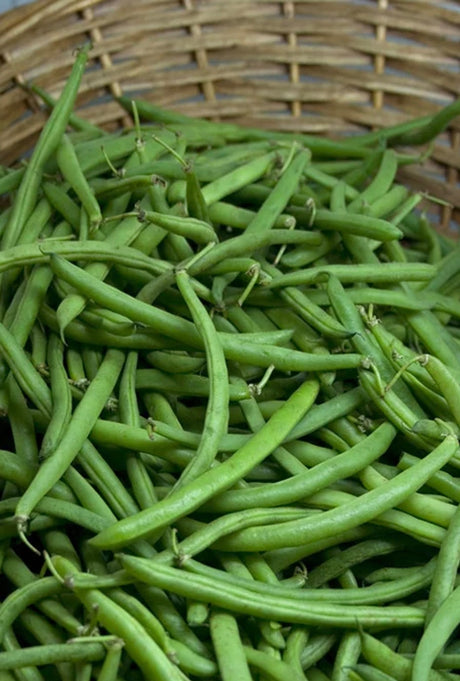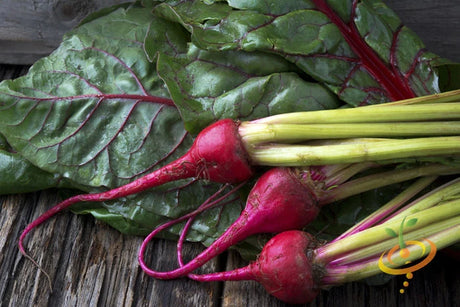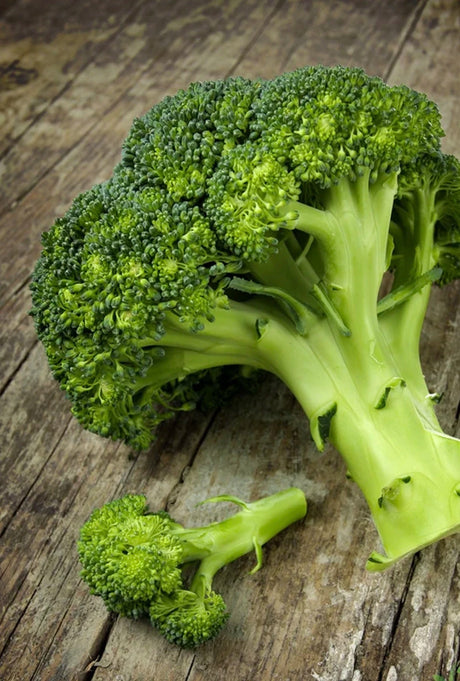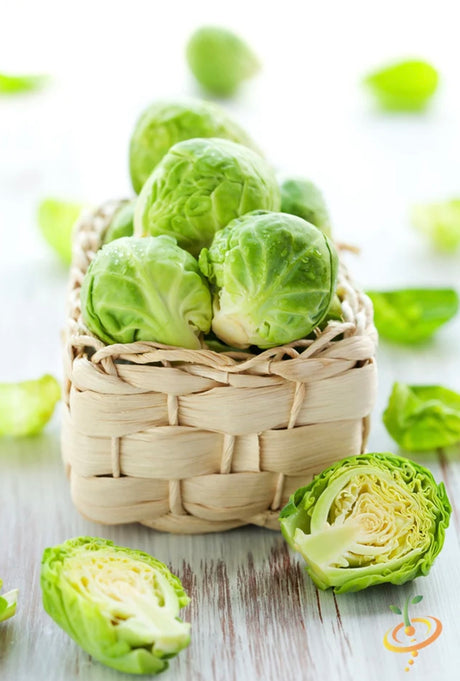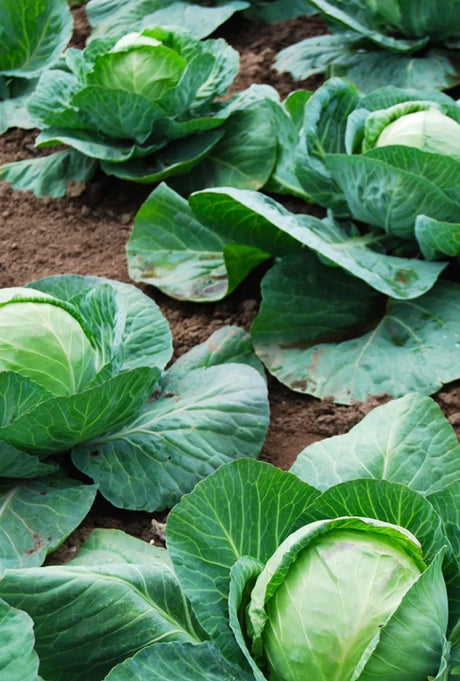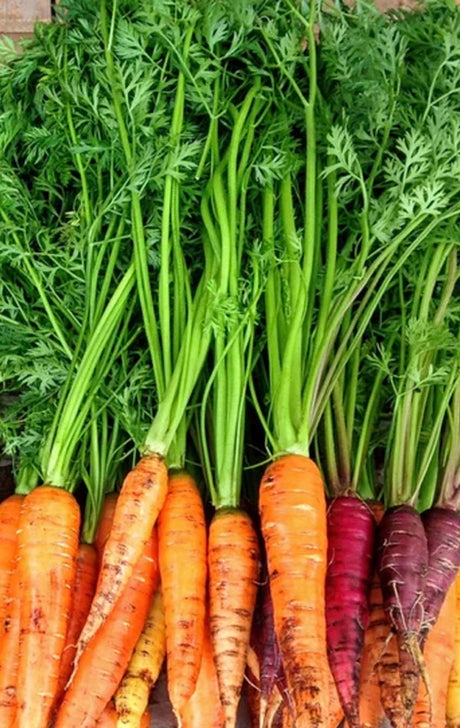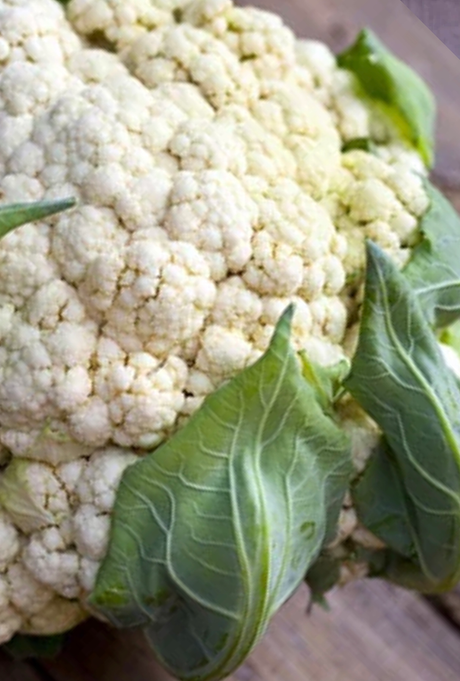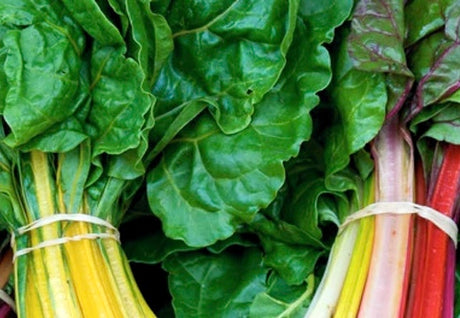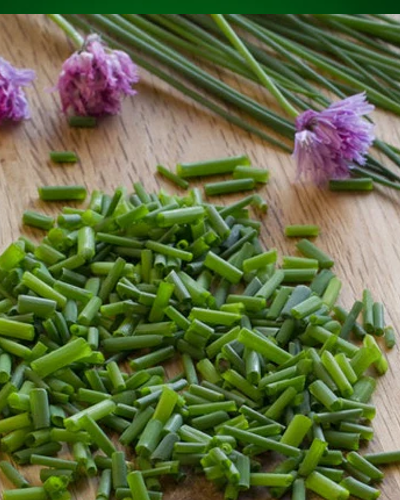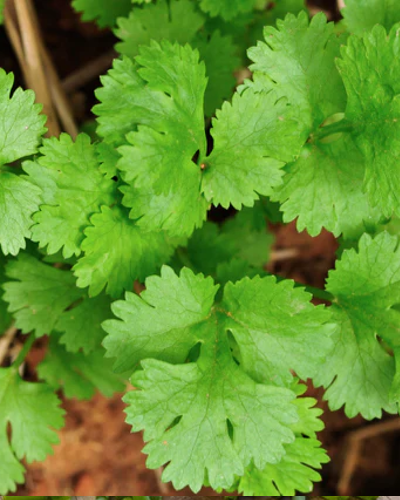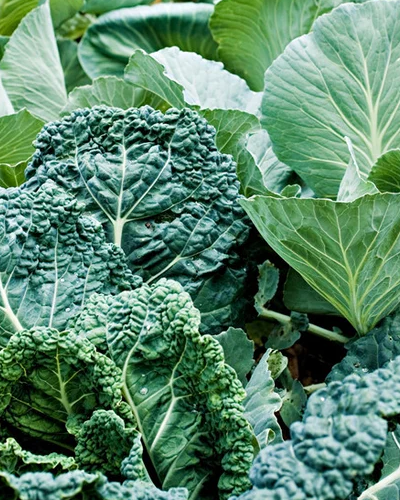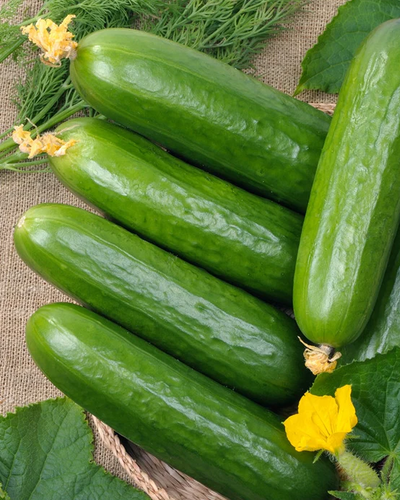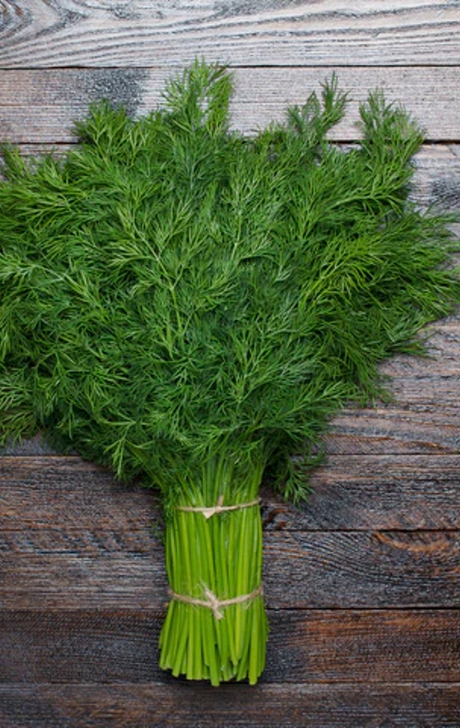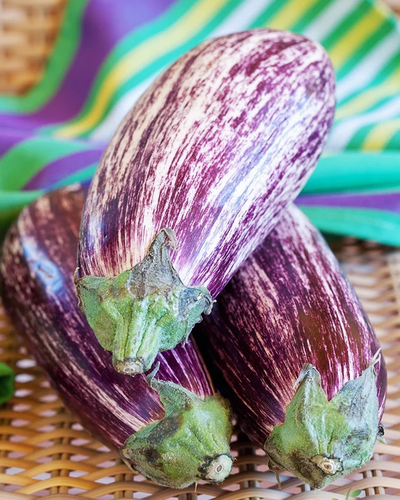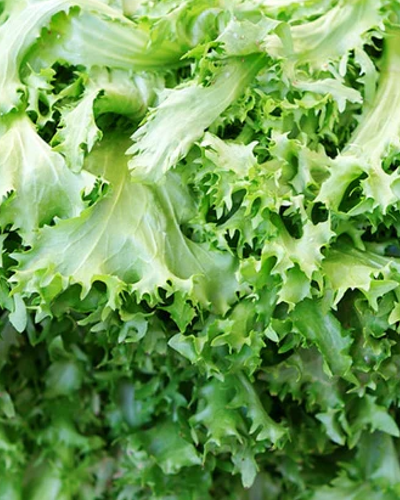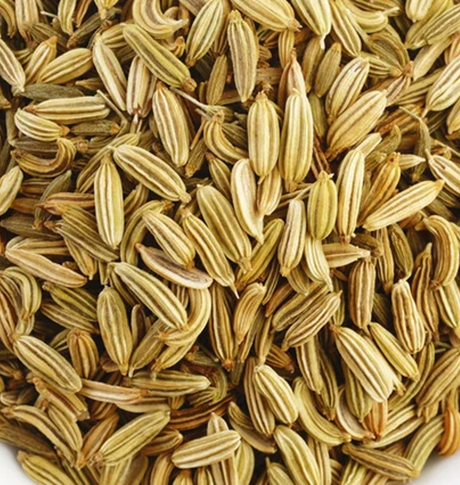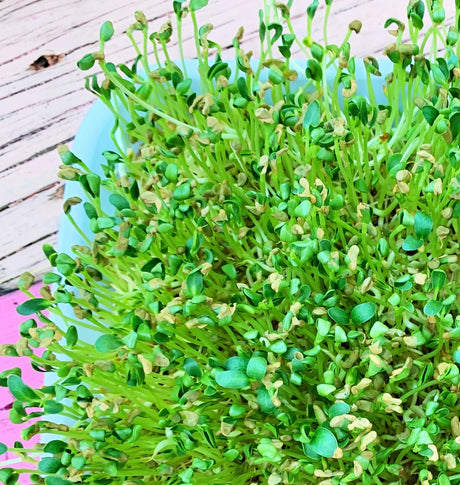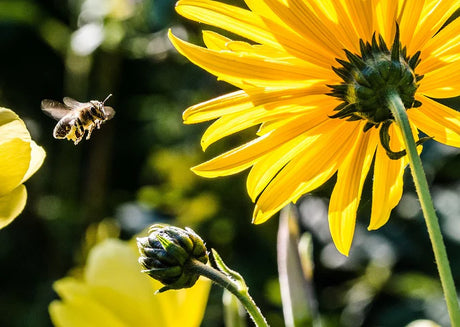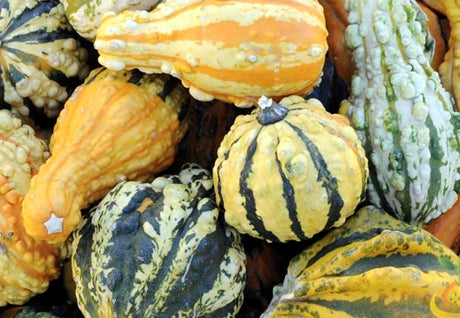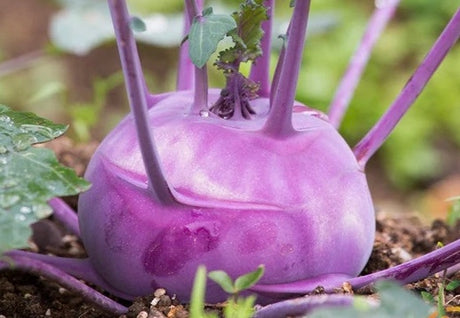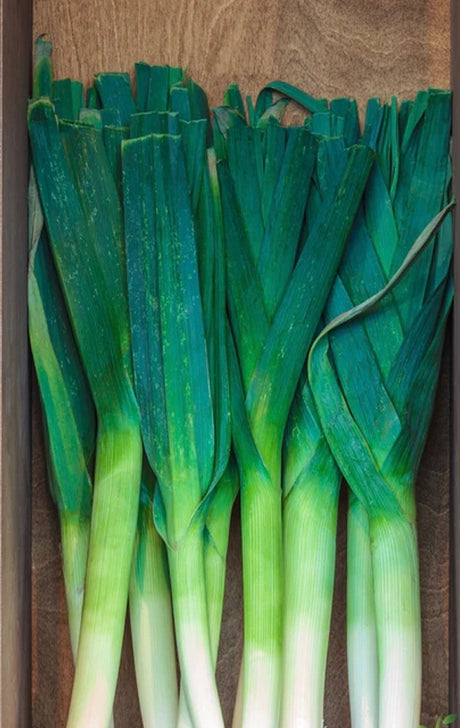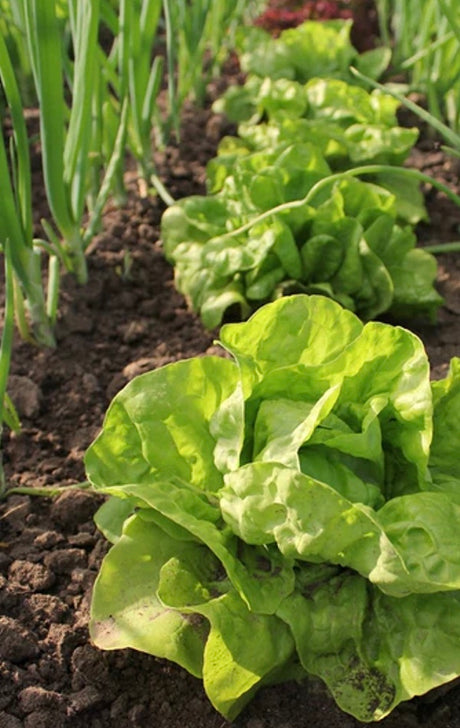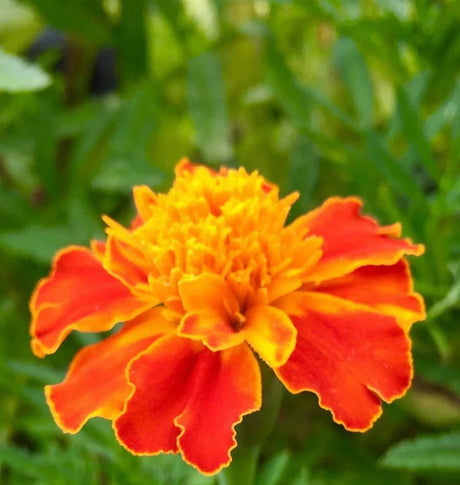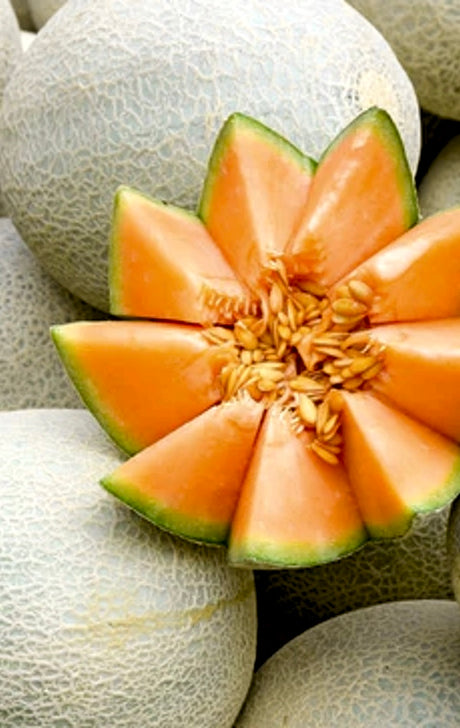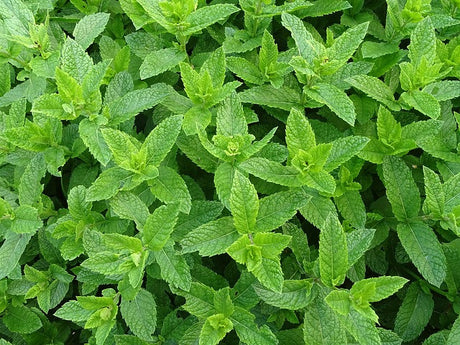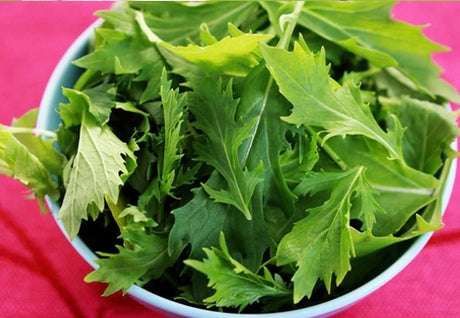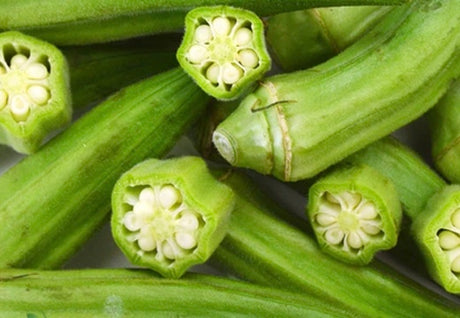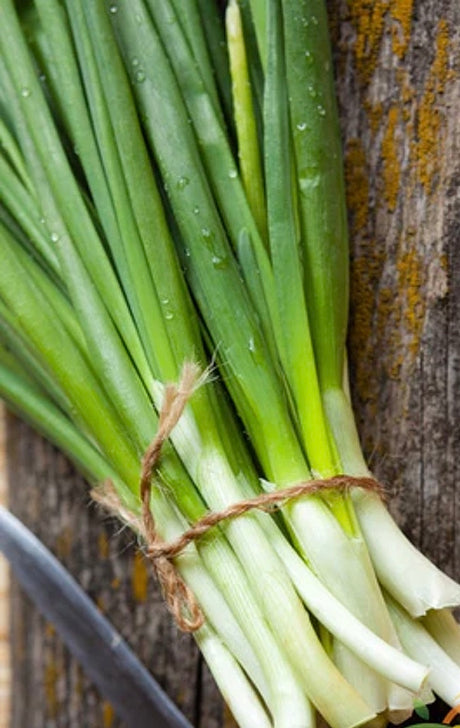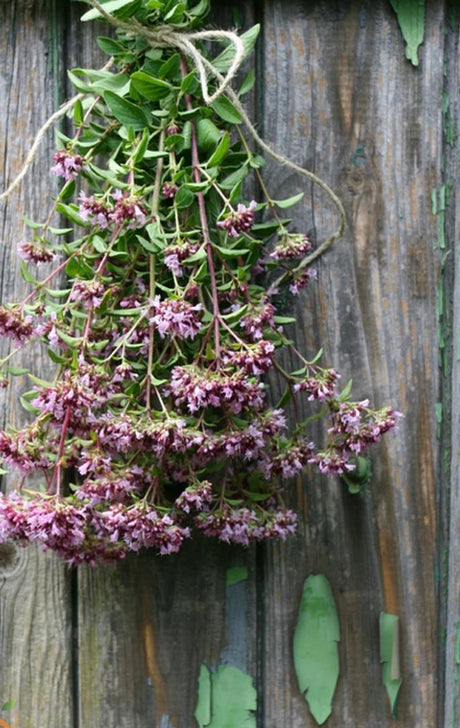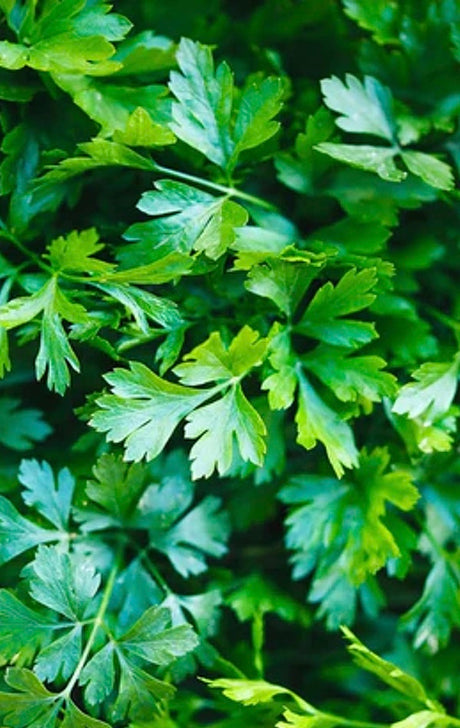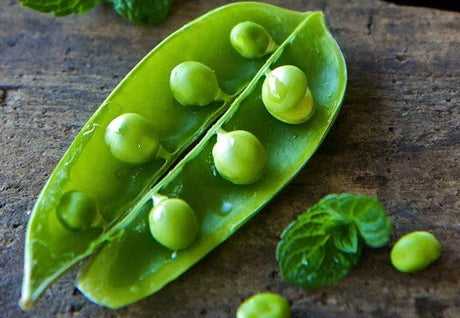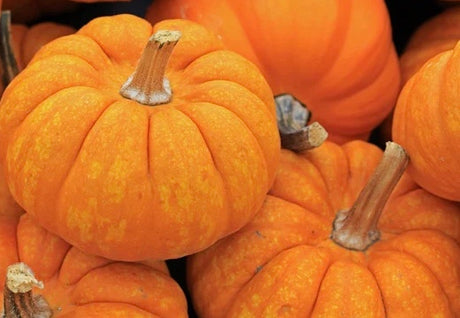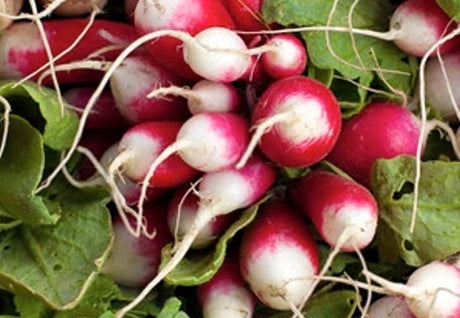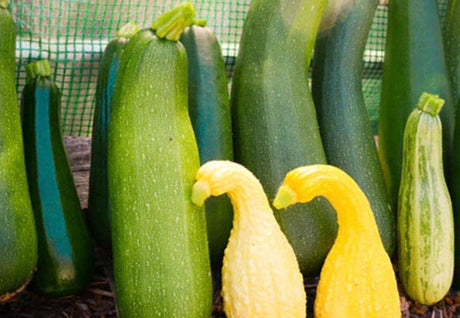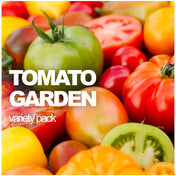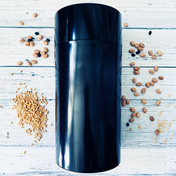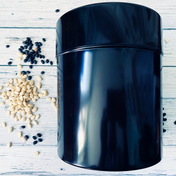- From $299 USDUnit price /Unavailable
Description
Greek Basil is a small-leaf dwarf variety that grows into a tight dome, about 1’ tall and wide. A great one for containers, hanging baskets, and indoor gardens. The bright green, oval leaves and soft stems have hints of clove and anise, and keep their flavor when dried. Use this variety to flavor herb butters and vinaigrettes, and the edible flowers as a garnish or salad green.Harvest the leaves and stems from the top part of the plant, and pinch off edible flower buds as they appear, which prevents the leaves from turning bitter, and signals the plant to branch out and grow more leaves, making a bushier plant.
The more you harvest, the more it grows!
- Basil-clove-anise flavor
- Compact plant
- Good for indoor gardens
- Good for containers
- Tons of medicinal benefits!
As a medicinal herb, Basil has been used internally to treat anxiety, colds, colic, cough, depression, diarrhea, fever, flatulence, flu, indigestion, insomnia, intestinal parasites and worms, exhaustion, gastric pain, gonorrhea, lactation problems, migraine headache, nausea, stomach cramps, sore throat, and vomiting, and externally to treat acne, insect bites and stings, loss of smell, skin problems, snake bites.
⚠️ Do not use medicinally while pregnant.
⚠️ Medicinal properties are presented as information only, and are not a recommendation or prescription for use. Consult a medical professional before using any herb medicinally.
As a companion plant, it attracts hummingbirds, pollinators, and beneficial insects, and repels asparagus beetles, cabbage moths, cabbage white butterfly, cabbage worms, carrot rust fly, flies, maggots, mice, mosquitoes, spider mites, thrips, and tomato hornworms.
Shop all Basil Seeds Shop Good Companion Plants for Basil 📚 Grow Guide: Basil


See Basil Recipes & Growing Tips on our Pinterest Board
Shop all Basil Seeds Shop Good Companion Plants for Basil 📚 Grow Guide: Basil - From $299 USDUnit price /Unavailable
Description
Lemon Basil, also called Hoary Basil (for its fuzzy stems), is a hybrid cross between traditional basil and lime basil.The bright green leaves have a sweet lemony aroma and a tangy lemon-anise flavor that’s best used fresh in seafood dishes, fruit salads, lemonade, cocktails, and salad dressings. Add at the end of cooking to preserve the citrus flavor, then garnish with the edible flowers.
Harvest the leaves and stems from the top part of the plant, and pinch off edible flower buds as they appear, which prevents the leaves from turning bitter, and signals the plant to branch out and grow more leaves, making a bushier plant.
The more you harvest, the more it grows!
- Tangy lemon-anise flavor
- Culinary and medicinal
- Good for indoor gardens
- Good for containers
- Tons of medicinal benefits!
As a medicinal herb, Basil has been used internally to treat anxiety, colds, colic, cough, depression, diarrhea, fever, flatulence, flu, indigestion, insomnia, intestinal parasites and worms, exhaustion, gastric pain, gonorrhea, lactation problems, migraine headache, nausea, stomach cramps, sore throat, and vomiting, and externally to treat acne, insect bites and stings, loss of smell, skin problems, snake bites.
⚠️ Do not use medicinally while pregnant.
⚠️ Medicinal properties are presented as information only, and are not a recommendation or prescription for use. Consult a medical professional before using any herb medicinally.
As a companion plant, Basil attracts hummingbirds, pollinators, and beneficial insects, and repels asparagus beetles, cabbage moths, cabbage white butterfly, cabbage worms, carrot rust fly, flies, maggots, mice, mosquitoes, spider mites, thrips, and tomato hornworms.
Shop all Basil Seeds Shop Good Companion Plants for Basil 📚 Grow Guide: Basil
Health Benefits of Lemon Basil
Basil is a known health tonic for expecting mothers and when mixed with tea it increases lactation in mothers. It is also a nerve tonic and young children are sometimes encouraged to chew on the leaves of basil because it stimulates brain cells and can increase memory.

See Basil Recipes & Growing Tips on our Pinterest Board
Shop all Basil Seeds Shop Good Companion Plants for Basil 📚 Grow Guide: Basil - From $299 USDUnit price /Unavailable
Description
Let us tell you about Lettuce Leaf Basil. It’s a lovely Italian basil that grows huge leaves as big as your hand, with a flavor that’s sweeter and less spicy than other basils. Its crinkles hold onto dressing in salads, you need only one leaf for a sandwich or wrap, and you can use the rest as you would any other basil. Save the edible flower spikes to garnish seafood dishes and cocktails.Harvest the leaves and stems from the top part of the plant, and pinch off edible flower buds as they appear, which prevents the leaves from turning bitter, and signals the plant to branch out and grow more leaves, making a bushier plant. The more you harvest, the more it grows!
- Sweet and mild
- Huge 5"-6" leaves
- Grows 1'-2' tall
- Good for containers
- Tons of medicinal benefits!
As a medicinal herb, Basil has been used internally to treat anxiety, colds, colic, cough, depression, diarrhea, fever, flatulence, flu, indigestion, insomnia, intestinal parasites and worms, exhaustion, gastric pain, gonorrhea, lactation problems, migraine headache, nausea, stomach cramps, sore throat, and vomiting, and externally to treat acne, insect bites and stings, loss of smell, skin problems, snake bites.
⚠️ Do not use medicinally while pregnant.
⚠️ Medicinal properties are presented as information only, and are not a recommendation or prescription for use. Consult a medical professional before using any herb medicinally.
As a companion plant, Basil attracts hummingbirds, pollinators, and beneficial insects, and repels asparagus beetles, cabbage moths, cabbage white butterfly, cabbage worms, carrot rust fly, flies, maggots, mice, mosquitoes, spider mites, thrips, and tomato hornworms.
Shop all Basil Seeds Shop Good Companion Plants for Basil 📚 Grow Guide: Basil
Health Benefits of Genovese Basil
Basil is a known health tonic for expecting mothers and when mixed with tea it increases lactation in mothers. It is also a nerve tonic and young children are sometimes encouraged to chew on the leaves of basil because it stimulates brain cells and can increase memory.

See Basil Recipes & Growing Tips on our Pinterest Board
Shop all Basil Seeds Shop Good Companion Plants for Basil 📚 Grow Guide: Basil - From $299 USDUnit price /Unavailable
Description
The Royal Burgundy Bush Bean has so many things going for it—colorful, beautiful, tasty, plentiful, long-producing—but the coolest thing is that it grows in cool weather. Dark purple 5"-6" pods produced high on the plant make for a doubly easy harvest. When cooked, watch them change color from royal purple to royal green.
- Easy to grow
- High yields
- Continuous production throughout growing season
- Grows in cool weather
SEED PLANTING TIPS
- Botanical name: Phaseolus vulgaris
- Depth to plant seeds: 1" deep
- Spacing between plants: 4" apart
- Spacing between rows: 18"-24" apart
- Days to germinate (sprout): 5-10 days
- Germination soil temps: 70F-85F
- Soil needs: 6.0-7.0 pH
- Sun needs: Full sun
- Frost hardy: No
- Planting season: Spring, summer, fall
- # of plants per sq. ft.: Appx. 4 plants per sq. ft.
- Days to maturity: 50-55 days
Click here to view our full Bean grow guide
Good companion plants: Cucumber, Pea, Rosemary, Thyme, Tomato
Bean, Runner/Pole - Scarlet Runner
From $299 USDUnit price /UnavailableDescription

The Scarlet Runner Pole Bean is just about as traditional a vegetable you can grow in your garden. Named for its showy red hummingbird attractors (flowers) it puts out on 6'-8' vines that will grow on fences, trellises, and yes, poles. This high-yielding runner bean produces foot-long pods with speckled red-purple beans, but pick them sooner for best flavor. Tolerates heat and drought, and doesn’t mind cool nights.
- Easy to grow
- Heat tolerant
- Long pods up to 8"-12”
- Eat fresh, shelled, or dried
SEED PLANTING TIPS
- Botanical name: Phaseolus coccineus
- Depth to plant seeds: 1" deep
- Spacing between plants: 5" apart
- Spacing between rows: 18"-24" apart
- Days to germinate (sprout): 8-14 days
- Germination soil temps: 70F-85F
- Soil needs: 6.0-7.0 pH
- Sun needs: Full sun
- Frost hardy: No
- Planting season: Spring, summer
- # of plants per sq. ft.: Appx. 4 plants per sq. ft.
- Days to maturity: 65-75 days
Click here to view our full Bean grow guide
Good companion plants: Cucumber, Pea, Rosemary, Thyme, Tomato
- From $299 USDUnit price /Unavailable
Description
- Annual plant
- Adds great flavor and color to many culinary creations
- 3 ft. plant with strongly aromatic foliage, stems, and heads
- Excellent for fresh pickling
-
Days to Maturity | 40 - 65 days
Additional Details
Dill has a very long history of herbal use going back more than 2,000 years. The seeds are a common and very effective household remedy for a wide range of digestive problems. An infusion is especially efficacious in treating gripe in babies and flatulence in young children. The seed is aromatic, carminative, mildly diuretic, galactogogue, stimulant and stomachic.
Other Medicinal Properties
Dill is also used in the form of an extracted essential oil. Used either in an infusion, or by eating the seed whole, the essential oil in the seed relieves intestinal spasms and griping, helping to settle colic. Chewing the seed improves bad breath. Dill is also a useful addition to cough, cold and flu remedies, it can be used with antispasmodics such as Viburnum opulus to relieve period pains. Dill will also help to increase the flow of milk in nursing mothers and will then be taken by the baby in the milk to help prevent colic.
See Dill Recipes & Growing Tips on our Pinterest Board
Follow SeedsNow.com's board Dill on Pinterest. Cabbage - Early Jersey Wakefield
From $299 USDUnit price /UnavailableDescription
- These seeds produces good yields of 2 lb heads of cabbage in the shape of a cone.
- Excellent flavor and very sweet.
- Open pollinated heirloom variety.
-
Days to Maturity | 65-75 days
-
Cabbage Seeds | ❄️ Cabbage is an annual cool-season crop, hardy to frost and light freezes. A smaller cabbage head has better flavor and can stay in the field longer without splitting. To keep them small, plant close together or, when the head is almost full, give the plant a sharp twist to break up the roots. 😀 Cabbage is a wide spreading foliage plant with handsome leaves that form a tight, hard ball head on a strong central stem. Young plants may bolt if grown at 50F for a long time; however mature plants of late varieties improve flavor in cold weather.
Click here for complete Cabbage grow guide
Did you know? Cabbage is an excellent source of vitamin C! It also contains significant amounts of glutamine, an amino acid that has anti-inflammatory properties. Cabbage can also be included in dieting programs, as it is a low calorie food.
- These seeds produces good yields of 2 lb heads of cabbage in the shape of a cone.
- From $299 USDUnit price /Unavailable
Description
- Sparky Marigold flowers are bright, bold, and beautiful
- Colors range from orange, red, and yellow
- Grows only 12" - 14" tall
- Most popular for attracting butterflies, bees, and other beneficial pollinators
- Sparky is easy to grow and will grow all summer
- Great for cut flowers and floral arrangements
- Sparky Marigold flowers are bright, bold, and beautiful
- From $299 USDUnit price /Unavailable
Description
- Mini pumpkins about the size of a grapefruit
- Tiny pumpkins weigh about 14 ounces
- Days to Maturity | 90 days
Additional DetailsThe word pumpkin originates from the word pepon, which is Greek for “large melon". The French adapted this word to pompon, which the British changed to pumpion and later American colonists changed that to the word we use today, "pumpkin".
- Mini pumpkins about the size of a grapefruit
- From $299 USDUnit price /Unavailable
Description
- Cal Sweet is one of the sweetest tasting and most popular watermelon varieties available
- A commercial grower favorite - sells well at farmers markets
- Dark green stripes on the exterior with bright red flesh
- Grows to appx. 35 lbs
- Perfect-sized watermelon for any-sized backyard
-
Days to Maturity | 90 days
-
Watermelons are heat-loving plants that need lots of sun. They grow on a long vine, so make sure to give them plenty of space to roam around.
Follow SeedsNow.com's board Watermelon on Pinterest. - Cal Sweet is one of the sweetest tasting and most popular watermelon varieties available
- From $299 USDUnit price /Unavailable
Description
- The Jubilee is a very long shaped watermelon
- Deep red flesh
- Grows up to appx. 40 lbs
-
Days to Maturity | 90 days
-
Watermelons are heat-loving plants that need lots of sun. They grow on a long vine, so make sure to give them plenty of space to roam around.
Follow SeedsNow.com's board Watermelon on Pinterest. - The Jubilee is a very long shaped watermelon
- From $299 USDUnit price /Unavailable
Description
-
These seeds produces a medium-to-large hard round heads of cabbage
- Suitable for spring, summer, and fall crops
- Cold hardy
- Stores well. Suitable for home gardens and market growers
- Perfect for Kraut recipes
-
Days to Maturity | 90 days
-
Cabbage Seeds | ❄️ Cabbage is an annual cool-season crop, hardy to frost and light freezes. A smaller cabbage head has better flavor and can stay in the field longer without splitting. To keep them small, plant close together or, when the head is almost full, give the plant a sharp twist to break up the roots. 😀 Cabbage is a wide spreading foliage plant with handsome leaves that form a tight, hard ball head on a strong central stem. Young plants may bolt if grown at 50F for a long time; however mature plants of late varieties improve flavor in cold weather.
Click here for complete Cabbage grow guide
Additional Details
Did you know? Cabbage is an excellent source of vitamin C! It also contains significant amounts of glutamine, an amino acid that has anti-inflammatory properties. Cabbage can also be included in dieting programs, as it is a low calorie food.
-
These seeds produces a medium-to-large hard round heads of cabbage
Corn Salad (Mache - Lamb's Lettuce) - Dutch
From $299 USDUnit price /UnavailableDescription
-
Valerianella locusta (aka Corn Salad) is a small annual plant that is eaten as a leaf vegetable. It has a characteristic nutty flavor, dark green color, and soft texture, and is popularly served as salad greens. //Wikipedia
- Corn Salad has a delicate flavor, similar to a butterhead lettuce. It is quite hardy and requires very little care while remaining practically free of pests & disease. Corn salad is also known for growing vigorously in almost any soil!
- We think Corn Salad tastes best right out of the garden with a light drizzle of olive oil and a squeeze of fresh lemon. Once you try this cold-hardy green, you'll be sure to make it a staple in your fall/winter gardens every year.
-
Day to Maturity | only 40 days
-
Valerianella locusta (aka Corn Salad) is a small annual plant that is eaten as a leaf vegetable. It has a characteristic nutty flavor, dark green color, and soft texture, and is popularly served as salad greens. //Wikipedia
Corn Salad (Mache - Lamb's Lettuce) - French
From $299 USDUnit price /UnavailableDescription
- Valerianella locusta (aka Corn Salad) is a small annual plant that is eaten as a leaf vegetable. It has a characteristic nutty flavor, dark green color, and soft texture, and is popularly served as salad greens. //Wikipedia
- Corn Salad has a delicate flavor, similar to a butterhead lettuce. It is quite hardy and requires very little care while remaining practically free of pests & disease. Corn salad is also known for growing vigorously in almost any soil!
- We think Corn Salad tastes best right out of the garden with a light drizzle of olive oil and a squeeze of fresh lemon. Once you try this cold-hardy green, you'll be sure to make it a staple in your fall/winter gardens every year.
-
Day to Maturity | only 40 days
Tomato - Bradley (Indeterminate)
From $299 USDUnit price /UnavailableDescription
The Bradley Tomato is a sweet little pink tomato. By sweet, we mean lightly sweet and slightly acidic. By little, well, that’s just what you say when you describe something darling; it’s a medium-sized fruit. As for pink, it’s a dark pink. To be precise, it’s a lightly sweet and slightly acidic medium-sized dark pink tomato. A reliable producer with good-old fashioned tomato flavor.
- Well-balanced flavor
- Dark pink color
- Reliable producer
- Good fresh or cooked
SEED PLANTING TIPS
- Botanical name: Solanum lycopersicum
- Growth type: Indeterminate, trellis support, regular pruning
- Tomato size: Medium
- Depth to plant seeds: .25" deep
- Spacing between plants: 24" apart
- Spacing between rows: 36"-48" apart
- Days to germinate (sprout): 7-14 days
- Germination soil temps: 75F-95F
- Soil needs: 6.0-6.5 pH
- Sun needs: Full sun
- Frost hardy: No
- Planting season: Spring, summer
- # of plants per sq. ft.: Appx. 1 plant per 2 sq. ft.
- Days to maturity: 75-80 days
Good companion plants: Basil, Borage, Onion, Parsley, Pepper
Tomato - Calypso (Indeterminate)
From $299 USDUnit price /UnavailableDescription
The Calypso Tomato is often referred to as a “common salad tomato". Calypso is tolerant of heat and humidity, and great for Southern gardens.
- Common tomato flavor
- Common tomato color
- Heat tolerant
- Great for Southern gardens
SEED PLANTING TIPS
- Botanical name: Solanum lycopersicum
- Growth type: Indeterminate, trellis support, regular pruning
- Tomato size: Medium
- Depth to plant seeds: .25" deep
- Spacing between plants: 24" apart
- Spacing between rows: 36"-48" apart
- Days to germinate (sprout): 7-14 days
- Germination soil temps: 75F-95F
- Soil needs: 6.0-6.5 pH
- Sun needs: Full sun
- Frost hardy: No
- Planting season: Spring, summer
- # of plants per sq. ft.: Appx. 1 plant per 2 sq. ft.
- Days to maturity: 75-80 days
Good companion plants: Basil, Borage, Onion, Parsley, Pepper
Tomato - Oxheart, Orange (Indeterminate)
From $299 USDUnit price /UnavailableDescription
The Orange Oxheart Tomato is what you call eye candy. High yields of deep orange heart-shaped fruits glowing against a backdrop of emerald green leaves provide a stunning visual in any garden. They’re tasty, too. Meaty, fruity, juicy slicers grow and ripen all summer long, giving you more time for more eyefuls.
You may also like: Pink Oxheart Tomatoes ⟐ Yellow Oxheart Tomatoes- Sweet and juicy
- Small seed core
- High yields
- Good fresh and cooked
SEED PLANTING TIPS
- Botanical name: Solanum lycopersicum
- Growth type: Indeterminate, trellis support, regular pruning
- Tomato size: Large (1-2 lbs.)
- Depth to plant seeds: .25" deep
- Spacing between plants: 24" apart
- Spacing between rows: 36"-48" apart
- Days to germinate (sprout): 7-14 days
- Germination soil temps: 75F-95F
- Soil needs: 6.0-6.5 pH
- Sun needs: Full sun
- Frost hardy: No
- Planting season: Spring, summer
- # of plants per sq. ft.: Appx. 1 plant per 2 sq. ft.
- Days to maturity: 75-85 days
Click here to view our full Tomato grow guide
Good companion plants: Basil, Borage, Onion, Parsley, Pepper
Pepper (Hot) - Holiday Marbles 🔥
From $299 USDUnit price /UnavailableDescription
The Holiday Marbles Pepper is an assortment of tiny peppers with a tiny spark of heat. Compact plants cast out lots of green peppers that ripen through cream, yellow, purple, orange, and red. Shoot fresh ones onto a salad, or play for keeps and dry them whole to use like peppercorns.- High yields
- Edible ornamental
- Harvest any color
- Good for containers
SEED PLANTING TIPS
- Botanical name: Capsicum annuum
- Pepper size: 1/4"-1/2"
- Scoville heat units (SHU): 300-500/mild
- Plant support: Tomato cage or stake
- Depth to plant seeds: 1/8" deep
- Spacing between plants: 12"-18" apart
- Spacing between rows: 24"-36" apart
- Days to germinate (sprout): 7-21 days
- Germination soil temps: 75F-85F
- Soil needs: 6.0-7.0 pH
- Sun needs: Full sun
- Frost hardy: No
- Planting season: Spring, summer
- # of plants per sq. ft.: Appx. 1 plant per sq. ft.
- Days to maturity: 90+ days
Good companion plants: Basil, Carrot, Cucumber, Eggplant, Okra, Rosemary, Sage, Squash, Tomato
All Peppers ⟐ Hot Peppers 📚 Hot Peppers Grow Guide - From $299 USDUnit price /Unavailable
Description
- Just as the name suggests, this style of gourd will produce a gourd that looks like chicken eggs (same colors and sizes)
- Just as the name suggests, this style of gourd will produce a gourd that looks like chicken eggs (same colors and sizes)
Watermelon - Moon & Stars (Red-flesh)
From $299 USDUnit price /UnavailableDescription
- The Moon & Stars Watermelon dark green rind and bright yellow spots.
- Yellow spots are very unique and can be small or large in size.
- All American classic heirloom watermelon. - Deep red flesh.
- Grows over 40 lbs!
-
Day to Maturity | 90 days
- Watermelons are heat-loving plants that need lots of sun. They grow on a long vine, so make sure to give them plenty of space to roam around.
Follow SeedsNow.com's board Watermelon on Pinterest. - The Moon & Stars Watermelon dark green rind and bright yellow spots.
Watermelon - Tendersweet (Orange-flesh)
From $299 USDUnit price /UnavailableDescription
- The Tendersweet Watermelon is a classic heirloom variety with dark orange flesh
- Very sweet and delicious - Grows up to 35 lbs!
-
Days to Maturity | 90 days
-
Watermelons are heat-loving plants that need lots of sun. They grow on a long vine, so make sure to give them plenty of space to roam around.
- The Tendersweet Watermelon is a classic heirloom variety with dark orange flesh
Cauliflower - Violetta (Purple)
From $299 USDUnit price /UnavailableDescription
- This Cauliflower variety produces large purple heads and surrounded by dark green leaves
- Continues to grow well for a long time
- Suitable for successional sowing all year round -
Days to Maturity | 65 days
-
Cauliflower Seeds | Cauliflower is an annual cool-season crop, half-hardy to frost and light freezes. Plant in rows 2 1/2 to 3 feet apart, with 2 feet between plants.
Click here for complete Cauliflower grow guide
- This Cauliflower variety produces large purple heads and surrounded by dark green leaves
- From $299 USDUnit price /Unavailable
Description
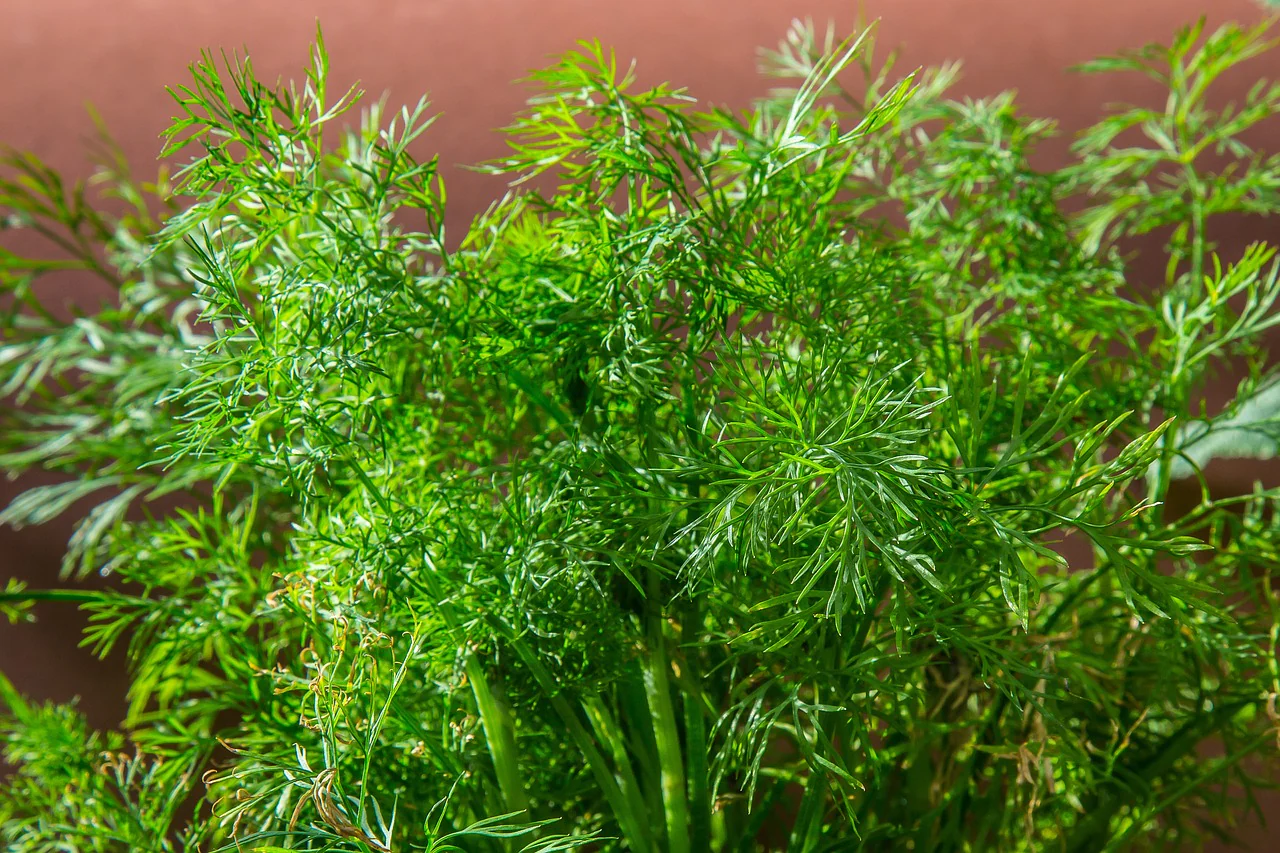
- Dukat dill is a particularly fine plant with amazing flavor and large heads. If you like dill you will love to try this new variety in your garden
- This variety is darker than most other dill varieties.
- Excellent fresh or dried.
- Grown for homemade dill pickles.
- Can be grown in containers, raised beds, and any other location in full sun.
- Annual plant.
- Adds great flavor and color to many culinary creations.
Additional Details
Dill has a very long history of herbal use going back more than 2,000 years. The seeds are a common and very effective household remedy for a wide range of digestive problems. An infusion is especially efficacious in treating gripe in babies and flatulence in young children. The seed is aromatic, carminative, mildly diuretic, galactogogue, stimulant and stomachic.
Other Medicinal Properties
Dill is also used in the form of an extracted essential oil. Used either in an infusion, or by eating the seed whole, the essential oil in the seed relieves intestinal spasms and griping, helping to settle colic. Chewing the seed improves bad breath. Dill is also a useful addition to cough, cold and flu remedies, it can be used with antispasmodics such as Viburnum opulus to relieve period pains. Dill will also help to increase the flow of milk in nursing mothers and will then be taken by the baby in the milk to help prevent colic.
See Dill Recipes & Growing Tips on our Pinterest Board
Follow SeedsNow.com's board Dill on Pinterest. - Dukat dill is a particularly fine plant with amazing flavor and large heads. If you like dill you will love to try this new variety in your garden
Coneflower, Purple Echinacea Flowers
From $299 USDUnit price /UnavailableDescription
Echinacea, also called Purple Coneflower, is an easy care perennial in the daisy family. Blooms bunches of blossoms with lavender petals skirting a brown spiky cone center atop sturdy stems that can grow 2'-4' tall. The leaves, flowers, buds, stems, and roots have been used medicinally for centuries, both dried and fresh, as an herbal tea, tincture, and oil infusion. Plant a deep pot, a small plot, or an entire lot!
- Immune system booster
- Attracts pollinators
- Long-lasting cut flower
- Good for containers
As a medicinal herb, Echinacea supports the immune system and has been used internally as a preventative against colds, flu, and chest congestion. It has also been used internally to treat anxiety, arthritis, asthma, colds, constipation, cough, depression, diphtheria, headache, inflammation, pain, rheumatism, sore throat, stomach cramps, strep throat, tonsillitis, tuberculosis, and whooping cough. Externally, Echinacea has been used to treat insect bites and stings, burns, dry or wrinkled skin, tired eyes, toothache, and wounds.
SEED PLANTING TIPS
- Botanical name: Echinacea purpurea
- Life cycle: Herbaceous perennial
- Hardiness zones: 3-9
- Planting season: Spring, summer, fall
- Days to maturity: 2 years; can begin harvesting when 6" tall
- Depth to plant seeds: Lightly cover - seeds need light to germinate
- Days to germinate (sprout): 7-30 days
- Germination soil temps: 65F-70F
- Spacing between plants: 12"-18" apart
- Spacing between rows: 18"-24" apart
- # of plants per sq. ft.: Appx. 1 plant per sq. ft.
- Soil types: Clay, sandy, loamy, silty, rocky, chalky, shallow, poor, rich, dry, well-drained
- Soil pH: 6.5-7.2
- Sun needs: Full sun, part shade
- Water needs: Low - do not overwater
- Cold stratify: Yes
- Frost tolerant: Yes
- Heat tolerant: Yes
- Drought tolerant: Yes
- Deer resistant: Yes
- Medicinal use: Yes

⚠️ Medicinal properties are presented as information only, and are not a recommendation or prescription for use. Consult a medical professional before using any herb medicinally.
- From $299 USDUnit price /Unavailable
Description

- Fruits are black and round
- Excellent flavor and a must -try if you you enjoy eggplant
- Easy to grow
-
Eggplant Seeds | Start seed indoors to allow at least 10 weeks for young plants to develop. Plant in rows 3 feet apart, with 2 feet between plants.
Click here for complete Eggplant grow guide
- Fruits are black and round
Onion - Walla Walla Sweet (Long Day)
From $299 USDUnit price /UnavailableDescription

- The Walla Walla Sweet Onion variety will produces a globed shaped white onion
- Bulbs can reach 2 lbs
- This is one of the most popular Long day onion varieties available
- Easy to grow
- Perfect for beginners
- Grows well in containers and tight spaces
-
Days to Maturity | 110-120 days
Onion Seeds | Onions are easy to grow, have a fairly short growing period and take up little space in the garden. Plant onions 1/4 inch deep and 3 to 4 inches apart in double rows, leaving 6 to 10 inches between rows.
Click here for complete Onion grow guide
- The Walla Walla Sweet Onion variety will produces a globed shaped white onion
- From $299 USDUnit price /Unavailable
Description

The Violet Star Artichoke is a dramatic alternative to the traditional Green Globe Artichoke. It produces a vibrant purple flower bud with a nutty flavor and creamy texture. Choose a sunny spot in your garden with lots of room for this dark beauty to grow. Artichokes are perennial plants that keep coming back bigger and more productive every year.
- Heat tolerant
- Drought tolerant
- Usually produces in 2nd year
- Perennial
Melon (Cantaloupe) - Heart of Gold
From $299 USDUnit price /UnavailableDescription

Heart of Gold Melon (100% Heirloom/Non-Hybrid/Non-GMO)-
The Heart of Gold melon produces a very sweet and delicious golden flesh fruit that grow up to 4 lbs!
-
Day to Maturity | 85-100 days
-
Melon Seeds | Because of the long growing season, start plants indoors 4 to 5 weeks before outdoor planting time. Direct sow 4-5 seeds in a hill and then thin to the appropriate spacing.
Click here for complete Melon grow guide
-
The Heart of Gold melon produces a very sweet and delicious golden flesh fruit that grow up to 4 lbs!
Tomato - Sub Arctic Plenty (Early) (Determinate)
From $299 USDUnit price /UnavailableDescription
The Sub Arctic Plenty (Early) Tomato is trying to tell you something: It produces a lot of fruits very quickly (45 days!), and really likes cooler temps. It would also like you to know that you can quickly (45 days!) grow the plants closer together without a stake or cage, or in a container or hanging basket. One more thing: It doesn’t sacrifice flavor or texture by ripening so many fruits so quickly (45 days!). You’ll harvest clusters of robust, red, juicy, tart, smallish medium-sized fruits in no time (45 days!). Plenty of them.
- Very high yields
- Very quick production—45 days!
- Good for containers
- Good for an early Southern or short Northern growing season
SEED PLANTING TIPS
- Botanical name: Solanum lycopersicum
- Growth type: Determinate, tomato cage support, no pruning
- Tomato size: Medium
- Depth to plant seeds: .25" deep
- Spacing between plants: 12"-24" apart
- Spacing between rows: 36"-48" apart
- Days to germinate (sprout): 7-14 days
- Germination soil temps: 75F-85F
- Soil needs: 6.0-6.5 pH
- Sun needs: Full sun
- Frost hardy: No
- Planting season: Spring, summer
- # of plants per sq. ft.: Appx. 1 plant per sq. ft.
- Days to maturity: 45-60 days
Click here to view our full Tomato grow guide
Good companion plants: Basil, Borage, Onion, Parsley, Pepper
Carrot - St. Valery/James Scarlet, 12" Long
From $299 USDUnit price /UnavailableDescription
- Old French variety that produces extremely sweet and delicious carrots up to 12” in length
- Tender, sweet, and smooth roots
-
Also known as the “James Scarlet”
-
Days to Maturity | 70 days
-
Carrot Seeds | Carrots are an annual cool-season crop, half-hardy to frost and light freezes. Sow seeds evenly in a very shallow furrow, about 1/4 inch deep, and keep seeds moist so they will germinate.
Click here for complete Carrot grow guide
Additional Details
Carrot gets its characteristic and bright orange colour from β-carotene, which is metabolised into vitamin A in humans when bile salts are present in the intestines. Carrots are also rich in dietary fibre, antioxidants, and minerals.
- Old French variety that produces extremely sweet and delicious carrots up to 12” in length
- From $299 USDUnit price /Unavailable
Description
The Snow White Carrot (Daucus carota) is a creamy white carrot with a crispy crunch and mild, sweet flavor. Grows 7" long with a tapered root. Harvest sooner for small carrots. Half-hardy to frost and light freezes. Good steamed, roasted, and fresh.
- Sweet and crunchy
- Size: 7" long
- Days to germinate (sprout): 7-21 days
- Days to maturity: 70-75
Good companion plants: Broccoli, Cauliflower, Chives, Lettuce, Onion, Parsley, Peas, Rosemary, Sage, Thyme, Tomato
SEED PLANTING TIPS
- Depth to plant seeds: .25" deep
- Spacing between plants: 2" apart
- Spacing between rows: 18"-24" apart
- Days to germinate (sprout): 7-21 days
- Germination soil temps: 65F-85F
- Soil needs: 6.0-6.8 pH
- Sun needs: Full sun
- Hardiness: Half-hardy to frost and light freezes
- Planting season: Spring, fall
- # of plants per sq. ft.: Appx. 16 plants per sq. ft.
- Days to maturity: 70-75 days
- From $299 USDUnit price /Unavailable
Description
The Golden Wax Bush Bean is a beautiful buttery treat in the garden. With its long, straight yellow pods, this heavy producing stringless bean is easy to cook or can. Grow these alongside Borlotti Bush Beans and Royal Burgundy Bush Beans for an artistic change from the usual green beans.
- Easy to grow
- Stringless variety
- Produces long 5"-7" pods
- Buttery wax bean flavor
SEED PLANTING TIPS
- Botanical name: Phaseolus vulgaris
- Depth to plant seeds: 1" deep
- Spacing between plants: 4"-6" apart
- Spacing between rows: 18"-24" apart
- Days to germinate (sprout): 10-14 days
- Germination soil temps: 70F-85F
- Soil needs: 6.0-7.0 pH
- Sun needs: Full sun
- Frost hardy: No
- Planting season: Spring, summer, fall
- # of plants per sq. ft.: Appx. 4 plants per sq. ft.
- Days to maturity: 65-75 days
Good companion plants: Cucumber, Pea, Rosemary, Thyme, Tomato
- From $299 USDUnit price /Unavailable
Description
The Purple Haze Carrot (Daucus carota) is dark purple on the outside and bright orange on the inside. Fun when sliced into coins. Grows 6"-8" with tapered roots, good texture, and sweet flavor. Half-hardy to frost and light freezes. Good steamed, roasted, and fresh.
- F1 hybrid
- Sweet and crunchy
- Size: 6"-8" long
- Days to germinate (sprout): 7-21 days
- Days to maturity: 70-75
- Can be harvested sooner for mini sized carrots
Good companion plants: Broccoli, Cauliflower, Chives, Lettuce, Onion, Parsley, Peas, Rosemary, Sage, Thyme, Tomato
SEED PLANTING TIPS
- Depth to plant seeds: .25" deep
- Spacing between plants: 2" apart
- Spacing between rows: 18"-24" apart
- Days to germinate (sprout): 7-21 days
- Germination soil temps: 65F-85F
- Soil needs: 6.0-6.8 pH
- Sun needs: Full sun
- Hardiness: Half-hardy to frost and light freezes
- Planting season: Spring, fall
- # of plants per sq. ft.: Appx. 16 plants per sq. ft.
- Days to maturity: 70-75 days
Tomato - Thessaloniki (Indeterminate)
From $299 USDUnit price /UnavailableDescription
The Thessaloniki Tomato is a Greek heirloom. A tomato so epic that Homer could have written an ode to its plump round fruits that ripen from golden yellow to vivid red, high yields in high temps, and a rich, earthy flavor that’s well-balanced between sweet and acidic. This one’s a keeper, both in the garden and on the countertop. By the time you eat a few of these, you may even be able to pronounce it.
- Well-balanced flavor
- Heat tolerant
- Early producer
- Stores well
SEED PLANTING INFO
- Botanical name: Solanum lycopersicum
- Growth type: Indeterminate, trellis support, regular pruning
- Tomato size: Medium
- Depth to plant seeds: .25" deep
- Spacing between plants: 24" apart
- Spacing between rows: 36"-48" apart
- Days to germinate (sprout): 7-14 days
- Germination soil temps: 75F-95F
- Soil needs: 6.0-6.5 pH
- Sun needs: Full sun
- Frost hardy: No
- Planting season: Spring, summer
- # of plants per sq. ft.: Appx. 1 plant per 2 sq. ft.
- Days to maturity: 75-80 days
Click here to view our full Tomato grow guide
Good companion plants: Basil, Borage, Onion, Parsley, Pepper
Sunflower, Maximillian Flowers
From $299 USDUnit price /UnavailableDescription
The Maximillian Sunflower (Helianthus maximiliani) is a drought-tolerant perennial. Produces a 3"-5" blossom with veined, pointed bright yellow petals around a dark golden center. Grows 3'-10' tall on branching, hairy stems with multiple blooms per stem, and long, narrow, drooping foliage. Bold, robust, and cheerful.
- Life cycle: Perennial
- Bloom season: Summer
- Attracts: Birds, bees, butterflies, and other pollinators
- Flower meaning: Admiration, devotion, happiness, honesty, loyalty, optimism, peace, vitality
SEED PLANTING TIPS
- Botanical name: Helianthus maximiliani
- Hardiness zones: 4-9
- Planting season: Spring, fall
- Days to maturity: 90-100 days
- Cold stratify: Yes
- Depth to plant seeds: 1/2" deep
- Spacing between plants: 36"-48" apart
- Days to germinate (sprout): 7-25 days
- Germination soil temps: 65F-70F
- Soil types: Clay, sandy, loamy, rocky, dry, well-drained
- Soil pH: 6.5-7.8
- Water needs: Low - do not overwater
- Sun needs: Full sun
- Frost tolerant: No
- Drought tolerant: Yes
- Deer resistant: Yes
Carrot - Lunar White, 12" Long
From $299 USDUnit price /UnavailableDescription
The Lunar White Carrot (Daucus carota) is a creamy-white carrot with a small core and mild, sweet flavor that grows 8"-12" long. Harvest sooner for smaller carrots. Half-hardy to frost and light freezes. Good steamed, roasted, and fresh.
- Sweet, mild flavor
- Size: 8"-12" long
- Days to germinate (sprout): 7-21 days
- Days to maturity: 70-75
- Can be harvested sooner for mini carrots
Good companion plants: Broccoli, Cauliflower, Chives, Lettuce, Onion, Parsley, Peas, Rosemary, Sage, Thyme, Tomato
SEED PLANTING TIPS
- Depth to plant seeds: .25" deep
- Spacing between plants: 2" apart
- Spacing between rows: 18"-24" apart
- Days to germinate (sprout): 7-21 days
- Germination soil temps: 65F-85F
- Soil needs: 6.0-6.8 pH
- Sun needs: Full sun
- Hardiness: Half-hardy to frost and light freezes
- Planting season: Spring, fall
- # of plants per sq. ft.: Appx. 16 plants per sq. ft.
- Days to maturity: 70-75 days
Carrot - Paris Market, 2" Round
From $299 USDUnit price /UnavailableDescription
The Paris Market Carrot (Daucus carota) is a tender, adorable 2" round carrot with very sweet flavor. Grows well in containers, shallow beds, and rocky soil. Half-hardy to frost and light freezes. Good steamed, roasted, and fresh.
- Very sweet and crunchy
- Size: 2" in diameter
- Days to germinate (sprout): 7-21 days
- Days to maturity: 35 days
Good companion plants: Broccoli, Cauliflower, Chives, Lettuce, Onion, Parsley, Peas, Rosemary, Sage, Thyme, Tomato
SEED PLANTING TIPS
- Depth to plant seeds: .25" deep
- Spacing between plants: 2" apart
- Spacing between rows: 18"-24" apart
- Days to germinate (sprout): 7-21 days
- Germination soil temps: 65F-85F
- Soil needs: 6.0-6.8 pH
- Sun needs: Full sun
- Hardiness: Half-hardy to frost and light freezes
- Planting season: Spring, fall
- # of plants per sq. ft.: Appx. 16 plants per sq. ft.
- Days to maturity: 70-75 days
Pea - Alaska Early (Earliest of All)
From $299 USDUnit price /UnavailableDescription
The Alaska Early Pea (Pisum sativum), originally named Earliest of All, has a lot of great qualities. As you can guess, it’s one of the earliest to produce in only 55 days. It’s a semi-dwarf frost-tolerant bush variety that grows to only 2'-3' tall and doesn’t require staking. And it produces lots of 2"-3" pods with 5-8 small, plump, smooth, peas inside. Nice flavor that isn’t too sweet. It was renamed in the late 1800s after the steamship Alaska. Can be grown in Alaska, the lower 48, and Hawaii.
- Not too sweet
- Full sun
- High yields
- Early maturity—55 days
- Good for containers
Good companion plants: Bean, Carrot, Cucumber, Parsley, Pepper, Sage, Spinach, Squash, Strawberry, Thyme
SEED PLANTING TIPS
- Botanical name: Pisum sativum
- Hardiness zones: 2-11
- Pea type: English/shelling - remove peas from pod before eating
- Growth habit: Bush - no support
- Depth to plant seeds: 1" deep
- Spacing between plants: 2"-3" apart
- Spacing between rows: 18"-24" apart
- Days to germinate (sprout): 7-21 days
- Germination soil temps: 40F-85F
- Soil needs: Clay, sandy, loamy, chalky, rich, moist, well-drained
- Soil pH: 5.5-7.0
- Sun needs: Full sun
- Frost tolerant: Yes
- # of plants per sq. ft.: Appx. 8 plants per sq. ft.
- Days to maturity: 55-60 days
- From $299 USDUnit price /Unavailable
Description
The Hollow Crown Parsnip (Pastinaca sativa) has a 100-year history as a delicious, hardy, versatile root vegetable. This relative to Carrots grows to 10"-12" with a smooth, white, tender root. Eaten raw, it’s nutty and sweet, turning buttery and slightly spicy when cooked. Hardy to frosts and freezes, which sweetens the flavor. Try them roasted or puréed and topped with Parmesan cheese.
- Sweet, nutty flavor
- Tender and buttery
- Sweeter after a frost
- Good fresh and cooked
Good companion plants: Anise, Bush Bean, Garlic, Lettuce, Onion, Oregano, Pea, Radish, Rosemary, Sage, Tomato, Wormwood
SEED PLANTING TIPS
- Botanical name: Pastinaca sativa
- Depth to plant seeds: 1/4" deep
- Spacing between plants: 2"-3" apart
- Spacing between rows: 18"-24" apart
- Days to germinate (sprout): 10-28 days
- Germination soil temps: 50F-75F
- Soil needs: 6.0-7.0 pH
- Sun needs: Full sun, part shade
- Frost tolerant: Yes
- Planting season: Spring, fall
- # of plants per sq. ft.: Appx. 9 plants per sq. ft.
- Days to maturity: 100-120 days
Sprouts/Microgreens - Pea, Brown Speckled
From $299 USDUnit price /UnavailableDescription
- Organic
- Ready to eat as a sprout just a soon as they pop.
- Sweet and delicious in salads and casseroles.
- Day to Maturity | 3-7 days
Follow SeedsNow.com's board Green Pea Sprouts on Pinterest. - From $299 USDUnit price /Unavailable
Description
Crosby's Egyptian beet (Beta vulgaris) is a distinctive variety of beet that has garnered attention for its unique flavor profile and adaptability in various growing conditions. This heirloom variety is characterized by its flat, round shape and vibrant red color, making it not only a nutritious addition to the diet but also an attractive choice for home gardeners.
The young greens are also edible and can be used in salads or cooked as a nutritious side dish. The versatility of Crosby's Egyptian beet allows it to be enjoyed in a variety of culinary applications, from roasting to pickling.
One of the notable advantages of growing Crosby's Egyptian beet is its resilience to various pests and diseases. This variety exhibits a degree of tolerance to common beet pests such as aphids and leaf miners, making it an excellent choice for organic gardening practices. Additionally, the deep taproot of the beet allows it to access nutrients and moisture from deeper soil layers, contributing to its overall robustness.
Harvesting Crosby's Egyptian beet can begin as early as 50 days after sowing, depending on the desired size of the roots. It is advisable to harvest beets when they reach a diameter of 2 to 3 inches for the best flavor and texture. The greens can also be harvested throughout the growing season, promoting continuous growth of the roots.
In summary, Crosby's Egyptian beet is a valuable addition to any garden, offering both aesthetic appeal and culinary versatility. Its ease of cultivation and resistance to pests make it an ideal choice for both novice and experienced gardeners. By incorporating this heirloom variety into your gardening repertoire, you can enjoy the benefits of fresh, homegrown produce while contributing to the preservation of traditional plant varieties.
Shop all Beet Seeds 📚 Beets Grow Guide Amaranth - Tri Color (Joseph's Coat) seeds
From $299 USDUnit price /UnavailableDescription
Amaranthus tricolor, commonly known as Joseph's Coat, is a vibrant and visually striking flowering plant that is often utilized in ornamental gardening. This species is characterized by its broad, colorful leaves that can display a range of hues including red, yellow, and green. The plant typically reaches a height of 2 to 4 feet and can spread up to 3 feet wide, making it a prominent feature in garden landscapes.
One of the notable aspects of Amaranthus tricolor is its adaptability to various soil types. It thrives in well-drained soils and can tolerate poor soil conditions, which makes it an excellent choice for gardeners looking to enhance their landscapes with minimal maintenance. The plant prefers full sun exposure, requiring at least six hours of direct sunlight each day to achieve optimal growth and color vibrancy.
In terms of cultivation, Amaranthus tricolor is relatively easy to grow from seeds. The seeds should be sown directly into the garden after the last frost date, as the plant is sensitive to cold temperatures. Germination typically occurs within 7 to 14 days under suitable conditions. Once established, the plant is drought-tolerant, requiring watering only during prolonged dry spells.
From a nutritional perspective, Amaranthus tricolor is not only ornamental but also edible. The young leaves can be harvested and consumed in salads or cooked as a green vegetable, providing a source of vitamins A and C, as well as essential minerals. This dual-purpose nature enhances its appeal for gardeners interested in both aesthetics and food production.
Furthermore, Amaranthus tricolor attracts beneficial insects, such as pollinators, which can enhance the overall health of the garden ecosystem. The flowers, which are small and clustered, bloom throughout the summer and into the fall, providing a continuous source of color and attracting various species of bees and butterflies.
In conclusion, Amaranthus tricolor is a versatile and attractive addition to any garden. Its vibrant foliage, ease of cultivation, and nutritional benefits make it a valuable choice for both ornamental and edible gardening. Gardeners should consider incorporating this plant into their landscapes to enjoy its beauty and contributions to biodiversity.
Health Benefits of Amaranth
Do you have grey hair? Amaranth helps to prevent premature graying, mainly due to the minerals it contains. It helps to lower bad cholesterol and also can reduce inflammation and ease pain. Especially important for people suffering from diabetes, heart disease, and stroke. Great for tackling high blood pressure and may even help prevent cancer. Don't forget it is a wonderful source of protein.
Ways to Consume Amaranth
Amaranth is a lot like quinoa as far as being a "protein packed" seed. You can roast, pop, or boil these seeds. Use as a breakfast cereal, or combine it with other grains. Amaranth is a wonderful soup thickener because of it's gelatinous quality when cooked. Cook the leaves of the Amaranth plant, similar to how you would cook/use spinach leaves.

See Amaranth Recipes & Growing Tips on our Pinterest Board
Pepper (Hot) - Mushroom, Red 🔥
From $299 USDUnit price /UnavailableDescription
The Hot Mushroom Pepper, scientifically known as Capsicum annuum, is a unique variety of chili pepper that is gaining popularity among gardeners and culinary enthusiasts alike. This pepper is characterized by its distinctive mushroom-like shape and vibrant color, which can range from green to red as it ripens. The plant typically reaches a height of 18 to 24 inches and produces fruit that can measure approximately 2 to 3 inches in length.
One of the notable features of the Hot Mushroom Pepper is its heat level, which is measured on the Scoville scale. This pepper generally falls within the range of 1,000 to 5,000 Scoville Heat Units (SHU), making it a moderately spicy option for those who enjoy a bit of heat in their dishes. For comparison, jalapeño peppers typically range from 2,500 to 8,000 SHU, indicating that the Hot Mushroom Pepper can provide a milder kick.
In terms of cultivation, the Hot Mushroom Pepper thrives in warm climates and requires full sun exposure for optimal growth. It is essential to plant these peppers in well-draining soil enriched with organic matter to ensure healthy development. The ideal soil pH for growing Hot Mushroom Peppers is between 6.0 and 6.8. Regular watering is crucial, especially during dry spells, as the plant prefers consistent moisture without becoming waterlogged.
Harvesting the Hot Mushroom Pepper typically occurs around 70 to 80 days after planting, once the fruit has reached its full size and color. It is advisable to use pruning shears or scissors to cut the peppers from the plant to avoid damaging the stems. The harvested peppers can be used fresh in salads, salsas, or cooked dishes, and they can also be dried or pickled for preservation.
In addition to their culinary uses, Hot Mushroom Peppers are also known for their health benefits. They are rich in vitamins A and C, as well as antioxidants, which can contribute to overall health and well-being. The capsaicin found in peppers has been studied for its potential anti-inflammatory properties and its ability to boost metabolism.
In summary, the Hot Mushroom Pepper plant is an excellent addition to any garden, offering both aesthetic appeal and culinary versatility. With proper care and attention, gardeners can enjoy a bountiful harvest of these unique peppers, enhancing their meals while reaping the health benefits associated with their consumption.
SEED PLANTING TIPS
- Botanical name: Capsicum annuum
- Plant support: Tomato cage or stake
- Depth to plant seeds: .25" deep
- Spacing between plants: 18"-24" apart
- Spacing between rows: 24"-36" apart
- Days to germinate (sprout): 7-21 days
- Germination soil temps: 75F-85F
- Soil needs: 6.0-7.0 pH
- Sun needs: Full sun
- Frost hardy: No
- Planting season: Spring, summer
- # of plants per sq. ft.: Appx. 1 plant per sq. ft.
- Days to maturity: 75-85 days
Good companion plants: Basil, Carrot, Cucumber, Eggplant, Okra, Rosemary, Sage, Squash, TomatoAll Peppers ⟐ Hot Peppers 📚 Hot Peppers Grow Guide Pepper (Hot) - Mushroom, Yellow 🔥
From $299 USDUnit price /UnavailableDescription
The Hot Mushroom Pepper, scientifically known as Capsicum annuum, is a unique variety of chili pepper that is gaining popularity among gardeners and culinary enthusiasts alike. This pepper is characterized by its distinctive mushroom-like shape and vibrant color, which can range from green to red as it ripens. The plant typically reaches a height of 18 to 24 inches and produces fruit that can measure approximately 2 to 3 inches in length.
One of the notable features of the Hot Mushroom Pepper is its heat level, which is measured on the Scoville scale. This pepper generally falls within the range of 1,000 to 5,000 Scoville Heat Units (SHU), making it a moderately spicy option for those who enjoy a bit of heat in their dishes. For comparison, jalapeño peppers typically range from 2,500 to 8,000 SHU, indicating that the Hot Mushroom Pepper can provide a milder kick.
In terms of cultivation, the Hot Mushroom Pepper thrives in warm climates and requires full sun exposure for optimal growth. It is essential to plant these peppers in well-draining soil enriched with organic matter to ensure healthy development. The ideal soil pH for growing Hot Mushroom Peppers is between 6.0 and 6.8. Regular watering is crucial, especially during dry spells, as the plant prefers consistent moisture without becoming waterlogged.
Harvesting the Hot Mushroom Pepper typically occurs around 70 to 80 days after planting, once the fruit has reached its full size and color. It is advisable to use pruning shears or scissors to cut the peppers from the plant to avoid damaging the stems. The harvested peppers can be used fresh in salads, salsas, or cooked dishes, and they can also be dried or pickled for preservation.
In addition to their culinary uses, Hot Mushroom Peppers are also known for their health benefits. They are rich in vitamins A and C, as well as antioxidants, which can contribute to overall health and well-being. The capsaicin found in peppers has been studied for its potential anti-inflammatory properties and its ability to boost metabolism.
In summary, the Hot Mushroom Pepper plant is an excellent addition to any garden, offering both aesthetic appeal and culinary versatility. With proper care and attention, gardeners can enjoy a bountiful harvest of these unique peppers, enhancing their meals while reaping the health benefits associated with their consumption.
SEED PLANTING TIPS
- Botanical name: Capsicum annuum
- Plant support: Tomato cage or stake
- Depth to plant seeds: .25" deep
- Spacing between plants: 18"-24" apart
- Spacing between rows: 24"-36" apart
- Days to germinate (sprout): 7-21 days
- Germination soil temps: 75F-85F
- Soil needs: 6.0-7.0 pH
- Sun needs: Full sun
- Frost hardy: No
- Planting season: Spring, summer
- # of plants per sq. ft.: Appx. 1 plant per sq. ft.
- Days to maturity: 75-85 days
Good companion plants: Basil, Carrot, Cucumber, Eggplant, Okra, Rosemary, Sage, Squash, TomatoAll Peppers ⟐ Hot Peppers 📚 Hot Peppers Grow Guide Pepper (Hot) - Pasillo Beijio 🇲🇽 (Pasilla de Oaxaca) 🔥
From $299 USDUnit price /UnavailableDescription
The Pasillo Beijio pepper, also known as the Pasilla de Oaxaca, is a unique variety of chili pepper that is highly regarded for its rich flavor profile and versatility in culinary applications. This pepper is native to Mexico 🇲🇽 and is often used in traditional dishes, making it a valuable addition to any garden focused on organic produce.
Characterized by its dark green to brownish color, the Pasillo Beijio pepper typically measures between 6 to 8 inches in length. When dried, it transforms into a deep, wrinkled pod that is commonly used in sauces, salsas, and as a seasoning for various dishes. The flavor of the Pasillo Beijio is often described as smoky and earthy, with a moderate heat level that ranges from 1,000 to 2,500 Scoville Heat Units (SHU). This makes it suitable for those who enjoy a mild to medium heat in their culinary creations.
In terms of cultivation, the Pasillo Beijio pepper plant thrives in warm climates and requires full sun exposure for optimal growth. It is advisable to plant these peppers in well-drained soil enriched with organic matter to promote healthy development. The plant typically reaches a height of 2 to 3 feet and can produce a substantial yield, making it an excellent choice for home gardeners looking to grow their own peppers.
When growing Pasillo Beijio peppers, it is essential to monitor the watering schedule carefully. These plants prefer consistent moisture but should not be overwatered, as this can lead to root rot. Fertilization with a balanced organic fertilizer can also enhance growth and fruit production. Harvesting should occur when the peppers are fully mature, which is indicated by their dark color and firm texture.
In addition to their culinary uses, Pasillo Beijio peppers are also rich in vitamins A and C, as well as antioxidants, contributing to their health benefits. Incorporating these peppers into your diet can support immune function and overall health.
In summary, the Pasillo Beijio pepper plant is an excellent choice for gardeners interested in growing flavorful and versatile peppers. With proper care and attention, this plant can yield a bountiful harvest that enhances both the garden and the kitchen.
SEED PLANTING TIPS
- Botanical name: Capsicum annuum
- Plant support: Tomato cage or stake
- Depth to plant seeds: .25" deep
- Spacing between plants: 18"-24" apart
- Spacing between rows: 24"-36" apart
- Days to germinate (sprout): 7-21 days
- Germination soil temps: 75F-85F
- Soil needs: 6.0-7.0 pH
- Sun needs: Full sun
- Frost hardy: No
- Planting season: Spring, summer
- # of plants per sq. ft.: Appx. 1 plant per sq. ft.
- Days to maturity: 75-85 days
Good companion plants: Basil, Carrot, Cucumber, Eggplant, Okra, Rosemary, Sage, Squash, TomatoAll Peppers ⟐ Hot Peppers 📚 Hot Peppers Grow Guide Tomato - Marglobe Improved (Indeterminate)
From $299 USDUnit price /UnavailableDescription
The Marglobe Improved tomato plant is a hybrid variety that has gained recognition among gardeners for its robust growth and high yield potential. This cultivar is particularly well-suited for home gardens, as it offers a combination of disease resistance and adaptability to various growing conditions. The Marglobe tomato is known for its round, medium-sized fruit, which typically weighs between 5 to 7 ounces and features a rich, red color when fully ripe.
One of the key advantages of the Marglobe Improved tomato plant is its resistance to common tomato diseases, such as Fusarium wilt and Verticillium wilt. Studies have shown that this variety can exhibit up to a 30% higher resistance to these diseases compared to non-hybrid varieties. This characteristic makes it an excellent choice for gardeners looking to minimize crop loss due to disease.
In terms of growth habits, the Marglobe Improved tomato plant is classified as an indeterminate variety, meaning it continues to grow and produce fruit throughout the growing season until frost. This trait allows for extended harvesting periods, often yielding fruit from mid-summer until the first frost in the fall. Gardeners can expect to harvest approximately 10 to 15 pounds of tomatoes per plant, depending on growing conditions and care.
When planting Marglobe tomatoes, it is essential to consider their sunlight and soil requirements. These plants thrive in full sun, requiring at least 6 to 8 hours of direct sunlight daily. Additionally, well-draining soil enriched with organic matter is crucial for optimal growth. Soil pH should be maintained between 6.0 and 6.8 for best results. Regular watering is also important, as tomatoes require consistent moisture to develop properly, with an ideal range of 1 to 2 inches of water per week.
To support the growth of Marglobe Improved tomato plants, gardeners may consider staking or caging the plants to prevent sprawling and to promote better air circulation. This practice can help reduce the risk of fungal diseases and improve overall fruit quality. Fertilization should be approached with care; a balanced fertilizer applied at planting and again during the growing season can enhance growth without leading to excessive foliage at the expense of fruit production.
In conclusion, the Marglobe Improved tomato plant is a valuable addition to any garden, offering a combination of disease resistance, high yield, and adaptability. By understanding its specific needs and growth habits, gardeners can successfully cultivate this variety and enjoy a bountiful harvest of flavorful tomatoes.
SEED PLANTING TIPS
- Botanical name: Solanum lycopersicum
- Growth type: Indeterminate, trellis support, regular pruning
- Tomato size: Medium
- Depth to plant seeds: .25" deep
- Spacing between plants: 24" apart
- Spacing between rows: 36"-48" apart
- Days to germinate (sprout): 7-14 days
- Germination soil temps: 75F-95F
- Soil needs: 6.0-6.5 pH
- Sun needs: Full sun
- Frost hardy: No
- Planting season: Spring, summer
- # of plants per sq. ft.: Appx. 1 plant per 2 sq. ft.
- Days to maturity: 70-80 days
Click here to view our full Tomato grow guide
Good companion plants: Basil, Borage, Onion, Parsley, Pepper
Sunflower, Evening Sun Flowers
From $299 USDUnit price /UnavailableDescription
The Evening Sun Sunflower (Helianthus annuus) is a striking annual plant that can enhance any garden with its vibrant colors and unique characteristics. This variety is particularly noted for its multi-colored blooms, which can range from deep red to golden yellow, creating a stunning visual display. The plant typically grows to a height of 5 to 7 feet, making it a prominent feature in garden landscapes.
One of the key benefits of the Evening Sun Sunflower is its ability to attract pollinators. Studies have shown that sunflowers are highly effective at drawing in bees and butterflies, which are essential for the pollination of many garden plants. In fact, a single sunflower can attract up to 20 different species of pollinators, thereby enhancing the biodiversity of the garden ecosystem.
In terms of cultivation, the Evening Sun Sunflower thrives in full sun and well-drained soil. It is recommended to plant seeds after the last frost date, as sunflowers are sensitive to cold temperatures. The seeds should be spaced approximately 12 to 18 inches apart to allow for adequate growth and airflow. Once established, these sunflowers require minimal maintenance, making them an excellent choice for both novice and experienced gardeners.
Furthermore, the Evening Sun Sunflower is known for its resilience. It can tolerate drought conditions once established, which is particularly beneficial in regions with variable rainfall. Research indicates that sunflowers can survive with as little as 1 inch of water per week, making them a sustainable choice for water-conscious gardeners.
In addition to their aesthetic appeal, Evening Sun Sunflowers also have practical uses. The seeds produced by these plants are edible and can be harvested for consumption. They are rich in nutrients, including vitamin E, magnesium, and selenium, contributing to a healthy diet. Moreover, sunflower oil, extracted from the seeds, is widely used in cooking and food production.
Overall, the Evening Sun Sunflower is an excellent addition to any garden. Its vibrant blooms, ability to attract pollinators, and minimal maintenance requirements make it a favored choice among gardeners. By incorporating this plant into your garden, you not only enhance its beauty but also contribute to a healthier ecosystem.
continue shopping
YOU MAY ALSO LIKE
View all-
$29999 USDUnit price /Unavailable
-
All-in-One Heritage Tomato Garden Variety Pack
$4499 USDUnit price /Unavailable -
All-in-One Mosquito Repellent Garden Variety Pack
$3999 USDUnit price /Unavailable -
All-in-One Medicinal Herb Garden Seed Bank
$9999 USDUnit price /Unavailable -
All-in-One Pepper Garden Variety Pack
$4499 USDUnit price /Unavailable -
All-in-One Chicken Garden Variety Pack
$3999 USDUnit price /Unavailable -
All-in-One Lettuce & Leafy Greens Variety Pack
$3999 USDUnit price /Unavailable -
All-in-One Culinary Herb Garden Variety Pack
$3999 USDUnit price /Unavailable -
All-in-One Homestead Seed Bank
$9999 USDUnit price /Unavailable -
All-in-One Medicinal Herb Garden Variety Pack
$4999 USDUnit price /Unavailable -
All-in-One Root Crop Garden Variety Pack
$3999 USDUnit price /Unavailable -
All-in-One Fall/Winter Variety Pack
$3999 USDUnit price /Unavailable -
All-in-One Sprouts/Microgreens Variety Pack
$3499 USDUnit price /Unavailable -
All-in-One Hydroponic Greens Variety Pack
$3999 USDUnit price /Unavailable -
All-in-One Fall/Winter Seed Bank
$8999 USDUnit price /Unavailable -
All-in-One Sprouts/Microgreens Seed Bank w/Sprouting Jar
$6999 USD$7999Unit price /Unavailable -
All-in-One Culinary Herb Garden Seed Bank
$8999 USDUnit price /Unavailable -
All-in-One Spring/Summer Seed Bank
$8999 USDUnit price /Unavailable -
All-in-One Urban Garden Variety Pack
$3999 USDUnit price /Unavailable -
All-in-One Cucumber Garden Variety Pack
$2999 USDUnit price /Unavailable -
*NEW!* Wildflower Scatter Garden Variety Pack
$3999 USDUnit price /Unavailable -
All-in-One SAVE THE BEES! Garden Variety Pack
$3999 USDUnit price /Unavailable -
All-in-One Salsa Garden Variety Pack
$4499 USDUnit price /Unavailable -
All-in-One Tower Garden Variety Pack
$3999 USDUnit price /Unavailable
FEATURED SEED COLLECTIONS
View all products listed A-Zcontinue shopping

















































































































